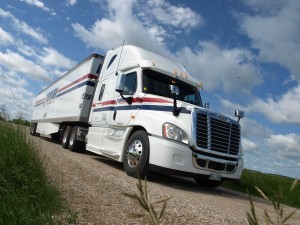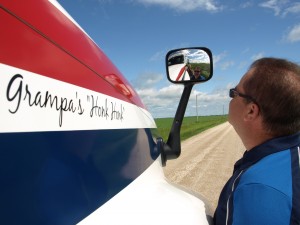The biggest complaint from Truckers is that cars do not understand stopping distances. Let’s say you’re coming up to a stop light and you see that you can gain a few feet because the truck beside you is approaching the light more slowly than you and you squeeze in and then stop hard. The trucker has to brake very hard to avoid a rear end collision, for which he would be at fault.
There are other problems. Think of a truck as a house on wheels; there are times when no amount of preventive work will stop the load from shifting. That costs the truckers money, which costs the shipper, and eventually the consumer.
Any suggestions for defensive car driving when sharing the road with trucks?
There are a few common sense things to do, in addition to what I mentioned above.
- Don’t pull in front of a trucks from a side street or anywhere if you can’t do so safely with lots of space.
- No texting, putting on makeup, chatting with the passenger or other distractions. Truckers have all seen people changing clothes (yes even bras and pants…) The car driver is distracted and the trucker may get distracted by nudity!
- Concentrate on smooth driving with your car making a straight line and no sudden moves. The road that was just passed may be the exit but it’s very easy to circle back safely. Much better than being hit by a truck, whose driver can’t stop as fast as you think he/she can.
- If you’re in a hilly area the truck may be slower going uphill. If that truck is trying to maintain a higher rate of speed than you on flat areas, then slow down and continue behind the truck. On the downhill he will pass you anyway if he can, and you become just another obstacle. This is especially aggravating on two lane roads. If a car is running 58 and the truck is going 63, that five mph difference may make him late or unable to get to a truck stop safely within the required time allowed by law. It’s very tough to pass cars on two lane roads. The trucker will be highly tempted to tailgate.
- Do not stay beside a truck. It makes them nervous. That’s where the bumper sticker comes from “Pass, follow, or just get the hell out of the way!”. If you’re going to follow closely, which is not recommended by law, but is commonplace, then drive for a bit with your car close to the centreline so the trucker can see someone is back there. If they don’t like it they may put on their left blinker. Then pass or fall back. If they don’t do anything pull directly behind again. In CB jargon that’s “in the rocking chair”.
One thing that terrifies me is the idea of a truck driver texting or even talking on a cell phone–even hands free–while driving.
Yes, it happens a lot. Too much. If the truck in front is weaving or speeding up and slowing down, he may be texting, or doing something else distracting. If the truck has a “How’s my driving?” decal then call that number with the provided unit number. Otherwise get a trailer and truck unit number and the company. Record the time, date, place (when safe) by pulling over or having a passenger do it for you. If there is imminent danger, stay back and call the police. You may save a life.
I’m not against talking handsfree in proper circumstances but each driver needs to be safe and use common sense.
Another fear is any driver who drives while sleepy (including airline pilots–how would we even know?); driving on too little sleep is the equivalent of driving drunk!
Too little sleep is worse than driving drunk. A drunk still has some control. Sleepy drivers don’t.
The government has just put in effect new rules July 1 this year. In a nutshell, truckers can drive to a maximum of 11 hours in a 14 hour period. Then they must take 10 hours off. Which equals 24 hours. The idea is to make drivers follow their natural sleep rhythms and force them to have longer breaks.
They’ve also clamped down hard on dispatchers so the roads are much safer today when it comes to sleepy drivers. A dispatcher can be jailed for pushing a driver past his legal hours.
It’s much safer today than when I started 26 yrs ago.
And yikes what about driving while on drugs or prescription meds?
Drug testing is mandatory for drivers and dock workers. Fatalities caused by truckers account for less than 10 percent in America. Drugged or alcohol related I think is less than 1 percent. When a trucker is involved in a wreck, it’s big news because the damage is terrible and very visible.
I take prescription meds and that is closely watched by my doctor.
If you’re on insulin you can’t drive.
Not too much to worry about in the big picture here. 😉
Once while chatting with a truck driver at a truck stop, I learned that he had worked for a (Canadian) company and the instructions were that if you think you are going to hit a car with, say, a family, then try to kill the occupants, as the financial settlement would be lower. Comments?
Yeah, there is a little of that attitude out there. One of our trucks was involved in a bad accident at a stop sign where people were killed. Our driver was stopped and not at fault. However, we are still fighting that. Truckers will be sued in any accident. It is your natural instinct is to avoid an accident so, the first move truckers make is to avoid hitting another vehicle. There’s only a split second to decide. I had the opportunity to either hit a car or hit the ditch. Short story: the guy in the car survived.
For many drivers, especially people from my era and before, the biggest fear is to kill someone (especially a child) in an accident. Whether it is your fault or not. Settlements have been decreasing slowly.
Anything else we should know?
Well Ms Worrywart… Be afraid. Be very afraid.
We are a highly regulated industry. Lots of paperwork.
Should be safe right? The government is protecting you.
Unfortunately, the quality of drivers is declining. Their regulations upset most experienced drivers so they are leaving in droves. When I tried becoming a truck driver it was very hard to get in. Many worked their way up from farming to driving a forklift to a small truck and up to a semi. We were also taken under the wing of the older drivers. So we appreciated what we had and knew we had to work hard to keep it.
Today people go from a Honda Civic to a semi in a few weeks. Unfortunately, the training itself is also severely lacking.
The government solution is more regulation. Yup, a vicious cycle. I got to the point where I consciously made a choice. Instead of bitching I actively use my experience to try to help other truckers become better professional drivers. I do this through talking to others, writing for Today’s Trucking, and my website. It’s easier to just complain because this work consumes a lot of my time. I like this industry, problems and all. I want to help make it better in any way I can.
I believe that we can and will improve. I appreciate you asking questions, and I look forward to more communication.
Afterthought from Dave:
After I sent off my response to you, I spent a lot of time trying to boil it all down to a nutshell. This is what I came up with, right or wrong. If at all possible, keep your distance from trucks. 😉



Leave a Reply